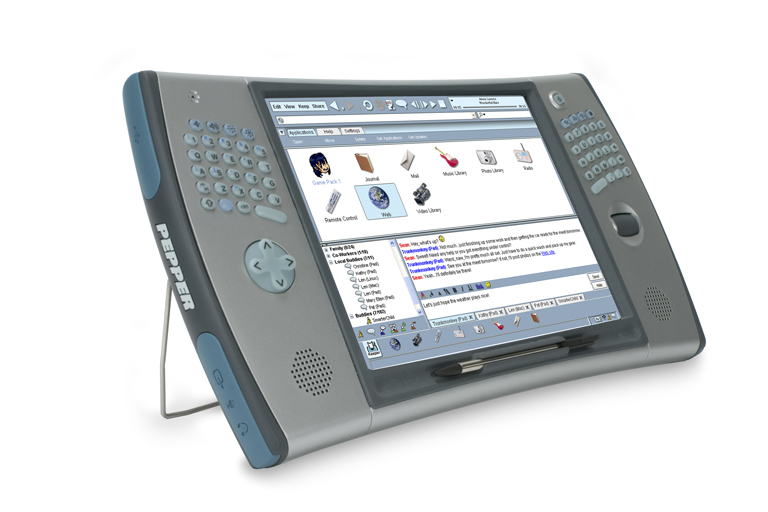The most amazing thing about the Pepper Pad is how easy it is to pick up and use, how easy it is to walk around with, and how it’s available when you want it and gone when you don’t.
The Pepper Pad‘s portability goes far beyond that of laptops. I mentioned previously that laptops move from desk to desk and Bill Gates tells us how poorly laptops work in elevators. Unlike laptops, the Pepper Pad takes a number of cues from from some of the most successful (and profitable) portable computing devices to come before it: the Game Boy and Playstation Portable. It’s no toy, but like those devices, the Pepper Pad works better in your hands than on a table — though the folding stand will keep it upright if you do put it down.
The split QWERTY keyboard on the left and right of the screen are among the Pepper Pad’s most distinctive features, but its positioning is a genius stroke. It neatly sidesteps the annoyances of handwriting recognition, and its position allows it to be easily ‘thumbed’ while standing or from in your lap. Small keyboards look awkward, but they seem to be catching on, especially on smartphones. I found the little keyboard easy to master during my time with it. As easy as it was to find the keys, though, I have to agree with Zach‘s request for more tactile feedback on the keypress.
These features are important because the use I have in mind requires a device that can be used without occupying the user’s full attention. Pepper’s Jon Melamut wants the Pepper Pad to be part of our lives, but not the object of our lives. He’s betting people will start thinking of web access like they do phones and TV remote controls — it’s best to have it in every room of the house.
Cell phones, in fact, may be a good model for Pepper. People don’t want phones, they want connectivity. Phone sales, unlike PC sales, are never based on the amount of RAM or CPU speed, and the phone’s operating system is rarely a factor. The Pepper Pad is designed for a post-PC world where a device’s ability to interact with various networks (web browsing, music streaming, instant messaging, VoIP (coming soon), etc) is more important than the details of the hardware or OS.
That said, it’s a good package. It’s got a bright 8.4 inch (800 x 600) touch screen, some good connectivity features (WiFi, Bluetooth, infrared, USB, audio in and out, composite video out, and a SD/MMC card slot), and the guts (624 Mhz CPU, 20GB HD, stereo speakers) and software (Linux, Mozilla, and a lot of Pepper-specific apps) that make it work all add up to a pretty attractive little device that weighs a little less than the latest Harry Potter (2.3 lbs). At 12.1“ x 6.6” x 0.8“ it’s large enough to be useful, but small enough to be unobtrusive and convenient.
Related: Zach blogged his reaction to the Pepper Pad over at NoSheep.net after our visit a week ago. Roger Sperberg has been writing about some related issues over at TeleRead.org, including this smart post about a computer you can use standing up. Also at TeleRead, David Rothman published some of my early reaction in a July 27th post. I wrote earlier about how I’d like to use the Pepper Pad in my library, and I’m interested in portable computing devices in general.
